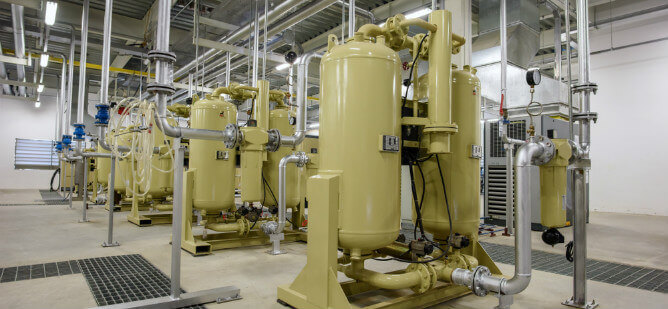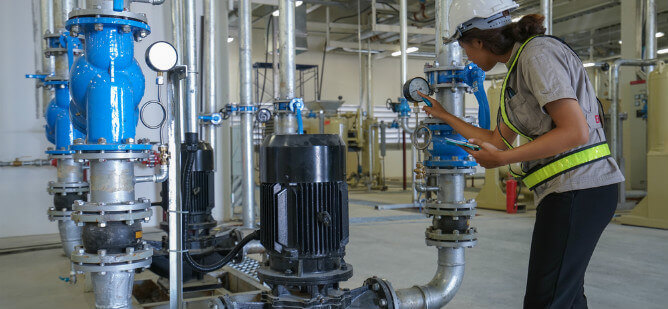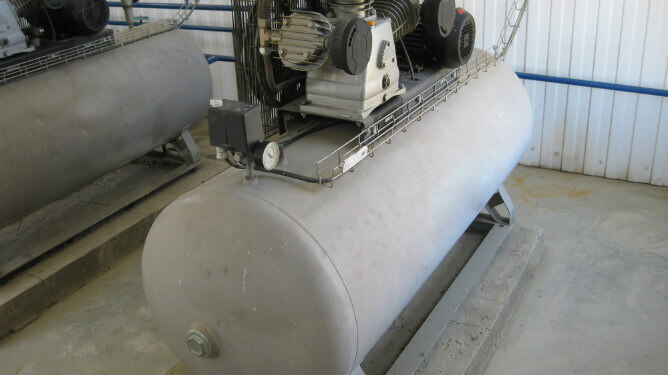
What is SCFM in Air Compressors – SCFM vs. CFM Explained
Air compressors are practical applications of Charles’ Law. This process turns power (electric power that pumps air) into potential energy in the form of pressurized air and kinetic energy to expel the gas or air. Many industries require air compressors to carry out various processes in their plants.
What is SCFM in Air Compressors?
Standard Cubic Feet per Minute (SCFM) is the flow rate of a gas or air through a compressor at standard temperature and pressure conditions. The standard temperature for calculating SCFM flow rate ranges from 60°F to 68°F, at a pressure of 14.7 psi and relative humidity of 36%. Since SCFM measures volumetric airflow at standard conditions, it will always be higher than the CFM value for a compressed air system.
What’s the Difference Between SCFM vs. CFM?
SCFM and CFM are both essential values that indicate the airflow rate in a compressor. SCFM measures this value based on ‘ideal’ temperature and pressure conditions, while CFM measures the ‘actual’ air flow rate. CFM is the recognized value for measuring the airflow rate in the United States.
CFM (Cubic feet per minute) measures the volume of air or gas that flows through a compressor in one minute. Sometimes, the CFM rating of an air compressor a manufacturer provides may have a margin of error. Therefore, the best way to determine your compressed air system’s most accurate CFM value is to test it in your facility.
SCFM to CFM Conversion Chart
SCFM and CFM vary with temperature and pressure. This chart helps estimate how air volume flow changes under different conditions.
Condition |
SCFM (Standard) |
Approximate Equivalent CFM |
Notes |
| 68°F @ 14.7 psi | 1 SCFM | 1.0 CFM | Standard condition; SCFM = CFM |
| 100°F @ 14.7 psi | 1 SCFM | ~1.07 CFM | Warmer air expands, so CFM increases |
| 32°F @ 14.7 psi | 1 SCFM | ~0.89 CFM | Colder air contracts, so CFM decreases |
| 68°F @ 12 psi (lower altitude) | 1 SCFM | ~1.20 CFM | Less pressure → more volume per minute |
| 68°F @ 16 psi (higher pressure) | 1 SCFM | ~0.92 CFM | Higher pressure → less volume per minute |
Note: These are approximate values to illustrate trends. Use precise calculations or manufacturer specifications for critical applications.
How to Calculate the CFM of an Air Compressor
You can find an air compressor’s CFM value using the following simple steps:
- Find the volume of the compressed air system tank in gallons. Most manufacturers specify this on the product.
- Divide the value by 7.48. This value will be your tank volume.
- Release air from the compressor.
- Refill the compressor with air, recording the time it takes to refill the tank while watching the gauge. Record the PSI (pounds per square inch) when the compressor kicks in and when it kicks out. You may call the first PSI measurement PSI 1 and PSI 2.
- Subtract PSI 1 from PSI 2 and divide the difference by 14.7. This value gives you the pressure in the compressor tank during refill (expressed in atmospheric pressure).
- Divide the tank volume you obtained earlier and multiply it with the pressure of the compressor tank during refill.
- Convert this value to minutes by dividing it by the number of seconds it took the compressor to pump that amount of air.
- Multiply the value by 60 to get the CFM of your compressed air system.
Knowledge of SCFM is quite useful when working with air compressors. Once you understand how to convert units into SCFM, you can easily convert SCFM to psi and vice versa.

Additional Air Compressor Ratings to Consider
After identifying the SCFM or CFM values, there are some other essential ratings to consider when choosing a compressed air system, such as:
PSI
PSI (Pounds Per Square Inch) indicates the amount of pressure forced through a compressor per square inch of area. Since pressure is inversely proportional to area, it increases as area decreases and vice versa.
Applications such as cutting, sealing, painting, sanding, and pounding require high PSI. Factory tools having PSI ratings from 40-90 may be enough to carry out most of these processes.
Horsepower (HP)
Horsepower measures the motor efficiency of an air compressor at a given CFM and PSI. It describes the working capacity of the machine and is one of the most recognizable properties to look out for before completing a purchase.
Depending on your application and for the optimum results, you can choose a compressed air system rated sufficiently higher than your current CFM.
Duty Cycle
Air compressors perform rigorous amounts of work, so for efficient usage, they operate on an on/off cycle, also called a duty cycle. During its off-cycle, the compressor is not necessarily turned off but isn’t actively pressurizing any volume of air.
Duty cycles are often specified as percentages, meaning that if a compressor has a duty cycle of 60/40, the compressor works for 60% of the time and is idled for the remaining 40%.
Gallons
Gallons refer to the storage capacity of an air compressor’s tank. Usually, the larger the gallon size of the compressor, the longer the air compressor can perform. This consideration is crucial for projects that require a continuous stream of airflow.

Air Tool SCFM Requirements Chart
Match your air compressor’s SCFM output to your tools’ demand. Use this guide to see what common tools typically need.
Air Tool |
Typical SCFM Required |
Operating PSI Range |
| Brad Nailer | 0.5 – 1.0 SCFM | 60 – 100 PSI |
| Framing Nailer | 2.2 – 2.5 SCFM | 100 – 130 PSI |
| Impact Wrench (1/2″) | 4.0 – 5.0 SCFM | 90 – 100 PSI |
| Angle Grinder (4″) | 5.0 – 8.0 SCFM | 90 – 100 PSI |
| Paint Sprayer (HVLP) | 6.0 – 12.0 SCFM | 40 – 70 PSI |
| Die Grinder | 4.5 – 6.0 SCFM | 70 – 90 PSI |
| Air Sander (Orbital) | 6.0 – 9.0 SCFM | 90 – 100 PSI |
| Sandblaster | 10.0 – 20.0+ SCFM | 100+ PSI |
Always choose a compressor that delivers at least 1.5x the SCFM required by your most demanding tool for continuous use.
Explore NiGen’s Reliable Air Compressors Today
Many industrial operators require compressed air in their operations, so having a standby rotary screw compressor is essential for optimal air compressor efficiency. NiGen is a supplier of high-performance on-site nitrogen generation systems and industrial air compressor rentals.
Visit our blog for more helpful resources, such as:
Have more questions about SCFM and CFM in air compressors? Please contact us online today!
